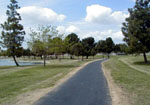Success Stories
Note: EPA no longer updates this information, but it may be useful as a reference or resource.
You will need Adobe Reader to view some of the files on this page. See EPA’s PDF page to learn more.
Many public agencies, private companies, and commercial landscapers across the country successfully use environmentally beneficial landscaping techniques. Check out their success stories below:
Agriculture
Recycling Plastics from Landscaping and Agriculture Industries | PDF Version (1 pg, 172K)
Agri-Plas, Inc., an agricultural plastic recycler in Oregon, processes tons of discarded plastics from the agricultural and nursery industries each year. The company collects trays, pots, and greenhouse films from about 100 nearby nurseries and picks up baling twine and plastic agricultural chemical containers from local farmers and growers. Agri-Plas provides the recovered plastic to end users that make new products for the nursery and automotive industries.

Using Compost on Vineyards | PDF Version (2 pp, 175K)
When a local vineyard contacted Jepson Prairie Organics for compost, the composting facility saw an opportunity to connect San Francisco with local vineyards. Organics are collected from San Francisco restaurants, composted, and used by vineyards. The use of local food scraps provides several benefits: not only do the vineyards realize savings of $5 - $10 per yard, but diners can order wine at these restaurants and effectively “close the loop.”
Commercial Sites
Benefits of Native Landscaping | PDF Version (2 pp, 121K)
Imagine a commercial landscape that never needs fertilizer, pesticides, extensive watering, or mowing. With WinterCreek Restoration’s native landscaping, the Century Park retail complex in central Oregon is nearly maintenance-free—and water, installation, and maintenance costs are significantly less expensive than traditional projects of a similar size.
Innovative Landscaping Techniques at Two EPA Facilities | PDF Version (2 pp, 192K)
At two EPA facilities, innovative landscaping techniques conserve water while helping the facilities meet federal environmental goals. Sustainable landscaping at EPA’s National Computer Center in Research Triangle Park, North Carolina, and EPA Region 8’s laboratory in Golden, Colorado, reduce the need for irrigation by using water-efficient designs and native plants suited to local conditions.

Parrot Jungle Island’s Holistic Approach to Landscape Site Development | PDF Version (2 pp, 191K)
Summer 2006 marked the second anniversary of Parrot Jungle Island’s environmentally sustainable landscaping project. The 18-acre park, located just south of Miami, Florida, completed an extensive four-year building plan, including elevation, vegetation, horticultural, irrigation, and cultivation changes. In the process, this GreenScapes practioner has shown that a holistic approach to landscape site development can be successful, cost-effective, and environmentally sound.
Golf Courses
Improving Turf with Compost | PDF Version (2 pp, 121K)
The soil on the North Shore Country Club (Glenview, Illinois) golf course had elevated sodium levels—too high to maintain quality turf. Standard procedure called for the installation of a well, but this project came with a quarter million dollar price tag. With a little research, North Shore found compost to be the economical alternative to enhance the quality of its soil.
Parks and Recreation

Reusing Deconstruction Material | PDF Version (1 pg, 171K)
When it was time for the Aspen Skiing Company to take down two buildings, the company chose to use deconstruction rather than demolition. By deconstructing, the company took the buildings apart and removed useable items. With only a little additional effort, Aspen found an alternative to sending all of their C & D waste to the landfill and saved more than $42,000 in avoided disposal costs on just one building.
Building a Recycled Plastic Bobsled Track | PDF Version(1 pg, 171K)
What better use for one million milk jugs and detergent bottles than creating a bobsled track? In the first application of plastic lumber specifically designed for a commercial structure, the Olympic Regional Development Authority created three staging platforms for the Lake Placid, New York bobsled track in preparation for the 2000 Winter Goodwill Games.
Queens Botanical Garden Uses Innovative Methods to Promote Sustainable Design | PDF Version (2 pp, 196K)
It’s getting a lot greener in Queens! Though surrounded by the concrete jungles of New York City, Queens Botanical Garden merges new technology with natural elements to reduce the environmental footprint of its newest buildings.
Recycling Tires into Park Equipment | PDF Version (2 pp, 174K)
Plagued by 10 million waste tires a year, Los Angeles county has saved landfill space by using recycled rubber in paths, playgrounds, and under structures throughout its district.
Incorporating Plastic Lumber in Parks | PDF Version (1 pg, 173K)
State parks in Indiana and Minnesota have realized the long-term benefits of using recycled plastic lumber as a construction material, replacing wood throughout the parks in projects ranging from viewing platforms and bridges to tables and benches.
Roads and Highways

Erosion Control Through Revegetation | PDF Version (2 pp, 121K)
GreenCover America, Inc. has succeeded in keeping the highway open. The company’s organic and environmentally friendly compost-based erosion control techniques have stabilized a steep, sandy slope where traditional erosion control methods had previously failed. Within months of installing a compost blanket, the site was covered.
Controlling Erosion with Compost | PDF Version (1 pg, 169K)
Filtrexx International LLC, has created a toolbox of erosion control methods utilizing compost. A great environmentally preferable product, compost is organic, biobased, annually renewable, recycled, and locally made. In addition, using compost to control erosion can be cheaper and more aesthetically pleasing than traditional methods. Compost is a lot more than just a fertilizer!
Roadside Composting | PDF Version (2 pp, 175K)
Texas Department of Transportation (TxDOT) has found that virtually barren roadsides became fertile grounds when compost was applied. This helped prevent the erosion of roads and surrounding grounds in many locations, and TxDOT has gone on a tour throughout the state to prove it!
Bridge Rehabilitation Through Reuse | PDF Version (1 pg, 173K)
Maine’s Department of Transportation saved $8.7 million by constructing a rural bridge from trash! 170,000 previously used shredded tires—20 percent of the waste tires generated in Maine in a year—were used in this project to support the roadbed, along with old bridge railings, roadside guard rails, and geotextiles.
Constructing a Milk Jug Bridge | PDF Version (1 pg, 100K)
The first bridge made entirely from recycled plastic has been constructed in New Jersey, capable of supporting 36,000 pounds. The super-strong plastic from which it is composed is formed through a new technique that combines multiple plastic polymers and results in plastic with enough strength and durability to be used as bridge I-beams, railroad ties, and much more.
![[logo] US EPA](../gif/logo_epaseal.gif)
